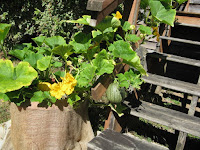 |
| 'Yellow Hawaiian' Heirloom Tomato |
I was at the Denman Island Farmer's Market last Saturday. There was a huge assortment of beautiful Heirloom tomatoes available in every color and shape imaginable (for a tomato). I also found a wonderful little bag of 'haricot vert' (skinny, little French green beans) that immediately called out to me ...'Bean Bundles'! Haricot verts are more tender with a more complex flavor than regular green beans.
With that inspiration, I came home and picked both red and yellow Heirloom tomatoes from my greenhouse. The week old bread that was destined for croutons conveniently became the bread for my salad instead.... and it became Panzanella time in my kitchen! The Bean Bundles are an adorable addition as a vegetable accompaniment and edible garnish.
 |
| Heirloom Tomato Panzanella with Bean Bundle |
Bean Bundles Yield: 6 servings
Salad;
6 large, fresh, ripe Heirloom Tomatoes;
diced into 1/2" pieces
1/2 large, sweet or red onion, thinly sliced
1/4 cup thinly sliced fresh basil leaves*
4 Tbsp. balsamic vinegar
1/2 cup extra virgin olive oil
1 tsp. freshly ground black pepper
1 tsp. sea salt
1 tsp. granulated sugar
6 cups day old, dense, crusty bread;
cut into 1" cubes
In a large bowl, whisk together balsamic vinegar, olive oil, pepper, salt and sugar. Add diced tomatoes, onion and basil; toss gently to combine. Set aside to allow the flavors to marry for about 10 minutes.
Add bread; toss well to coat. If the bread seems dry, sprinkle with a tablespoon or two of tomato water. Salad will hold for several hours at room temperature before serving.
*Chef's Tip: to slice basil; stack the leaves and roll up like a cigar. Hold tightly and slice very thin into a 'chiffonade'.
Bean Bundles;
36 haricot vert or thin green beans; if too thick, cut in half lengthwise
6 strips of carrot or green onion tops for ties
To prepare the ties; use a vegetable peeler and peel long strips of carrot OR use the tops of green onions. Place in a shallow container and pour boiling water over them to soften; drain and rinse under cold water. Cut into narrow strips. Tie groups of 6 beans into bundles, cutting off the ends of the ties.
Place a vegetable steamer over boiling water. Gently place the bundles in the steamer basket and steam for 8 minutes. Serve as a vegetable accompaniment.
Till next week ... Bon Appétit!
Photos by Sally Rae









